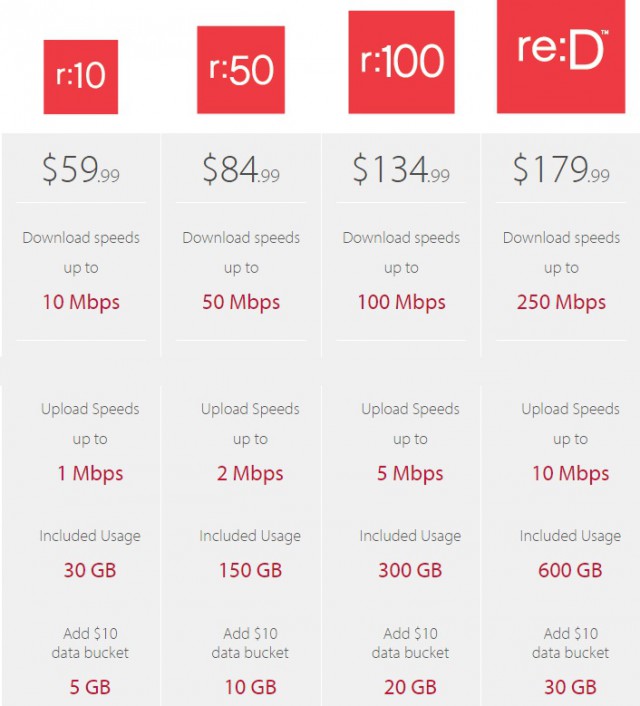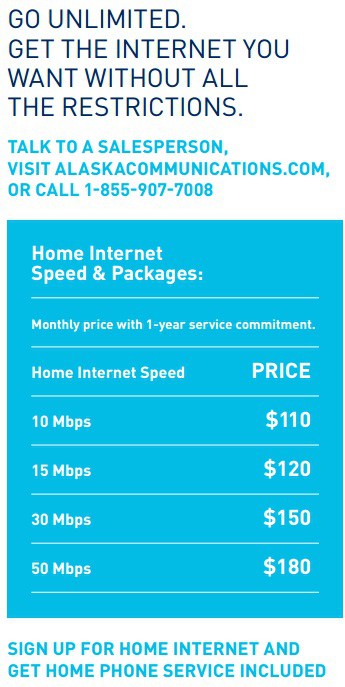 Alaska’s largest cable company today unveiled changes to its Internet plans, ditching surprise overlimit fees in favor of a speed throttle.
Alaska’s largest cable company today unveiled changes to its Internet plans, ditching surprise overlimit fees in favor of a speed throttle.
GCI has been the subject of bad press in the past, with some customers experiencing up to $1,200 in overlimit fees after exceeding GCI’s usage allowances. In an effort to avoid public relations nightmares like that, GCI will stop assessing automatic overlimit fees and instead impose a speed throttle on customers over their limit that will temporarily reduce broadband speeds to less than 1Mbps until the next billing cycle begins. Customers can voluntarily pay for more usage in $10 increments, which buys a reprieve from the speed throttle.
GCI “No Worries” Broadband Plans offer varying usage caps and extra usage allotments:

Customers on lower speed plans continue to face a lower usage allowance and will receive considerably less extra data for their $10 add-on data plan. GCI’s highest speed re:D offering does get a bigger usage allowance: 600GB, up from 500GB. An $11.99/mo surcharge continues for broadband-only customers.
GCI’s largest competitor remains telephone company ACS, which heavily markets its unlimited usage DSL plans. Almost as an afterthought, ACS now markets packages that include landline service with unlimited local calling and 180 minutes of long distance for free.

A price comparison between the two providers is somewhat hampered by the fact GCI does not publicize a broadband+home phone bundle package on their website. GCI Home Phone is priced at $19.99 a month.
A 10Mbps unlimited use package from ACS costs $110/month. A 10Mbps plan from the cable company with a 30 40GB allowance + GCI Home Phone costs $79.98. On price, GCI wins at this speed… if you stay within your allowance. A 50Mbps unlimited use package from ACS runs $180 a month. GCI charges $104.98 with 150GB of included usage. Again, the price winner is GCI if you stay within your allowance. Taxes, surcharges and government fees are extra.
Heavier users may find ACS’ initially higher prices worthwhile if they are forced to buy GCI’s add-on data buckets. Both companies charge considerably more than providers in the lower 48 states.
Last year, nearly 10% of GCI’s revenue was earned from automatically applied overlimit fees. Giving up some of that revenue is a concession, but one that is likely to end bill shock and negative media attention. Still, usage allowances remain arbitrary. GCI’s entry level 10Mbps plan only offers a paltry 30 40GB a month — an allowance largely unheard of among other U.S. cable providers. GCI will also have a difficult time explaining why $10 will only offer one customer 5GB of extra usage while others will get up to 30GB. The costs for the additional data to GCI are the same.
Our thanks to an anonymous reader for sharing the news.
Updated 4:08pm EST 1/15: After going to press, GCI changed their website, adjusting the usage allowance for their 10/1Mbps plan to 40GB (up from 30GB) and deleted references to the $11.99 surcharge for broadband-only customers, which apparently no longer applies.


 Subscribe
Subscribe AT&T has
AT&T has  AT&T calls the FTC’s claims it can intervene in services not regulated by the FCC “irrelevant,” arguing once one of AT&T’s services is subject to the FCC’s common carrier regulation, all of its services become untouchable by the FTC.
AT&T calls the FTC’s claims it can intervene in services not regulated by the FCC “irrelevant,” arguing once one of AT&T’s services is subject to the FCC’s common carrier regulation, all of its services become untouchable by the FTC.

